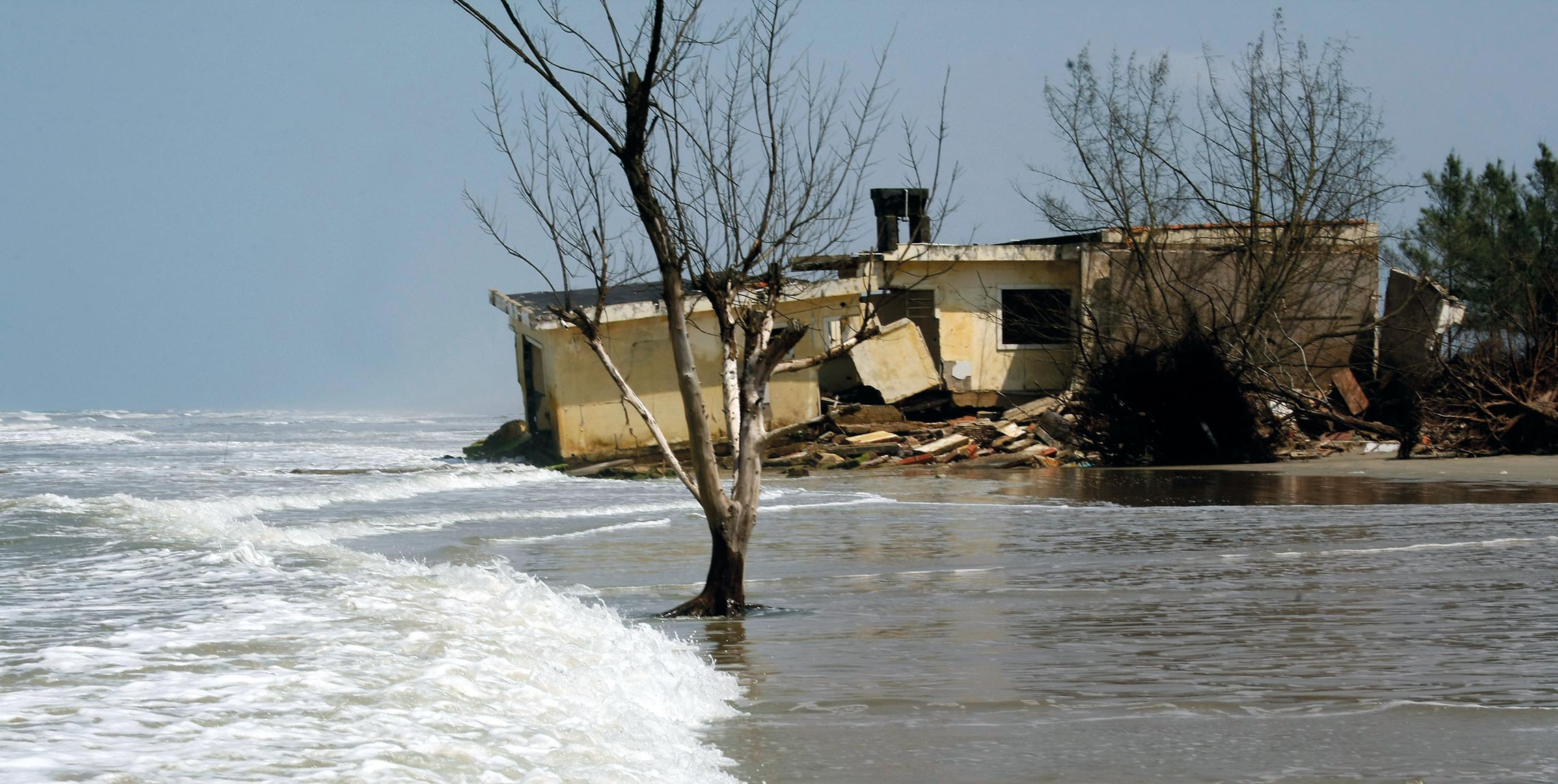The cliff that supports the Ponta do Seixas lighthouse in João Pessoa, Paraíba, the easternmost point of Brazil, has been washed away by the sea. In 2014, a stretch of road leading to the lighthouse collapsed. Two years later, the road was closed—initially only for cars, but later to pedestrians and cyclists too. Those arriving at Ponta do Seixas, now via a longer road, are welcomed by a beautiful view of the Atlantic ahead, and to their left, the ruins of the old road and a sign warning of the risk of collapse. Restoration work did not begin until October 2018.
As well as swallowing coastal roads, erosion of the Brazilian shoreline has had a variety of other ill effects. Beaches are marked by ravines and craters. Previously submerged rocks are now clearly visible. Houses crumble and foundations are exposed. Palm trees fall, their roots revealed due to the loss of supporting earth. In a book published by the Brazilian Environment Ministry (MMA) in November, the second version of a survey conducted by the Marine Geology and Geophysics Program—a network of Brazilian scientific institutions—indicated that erosion and sediment accumulation (known as progradation) affect 60% of the 7,500 kilometers (km) of Brazilian coastline. The first version of the survey, released in 2003, indicated that 40% of the coast (roughly 3,000 km) had suffered erosion. That figure has now increased by 50%, to 4,500 km.
The impact is greater in the North and Northeast of the country, where 60–65% of the coastline is affected by erosion, according to the report Overview of coastal erosion in Brazil. The state of Pará stands out in the survey, with 60% of its 562 km shoreline damaged by erosion and 30% affected by progradation. On the island of Marajó, the coastline—the displacement of which indicates the state of preservation or alteration of the beaches—has advanced by up to 100 meters (m) on some beaches due to sediment accumulation, while on others it has retreated by up to 80 m due to erosion. In Bahia, 20% of the state’s 932 km coastline has suffered erosion. In Sergipe, sediment loss has changed 38% of the 163 km of beaches.
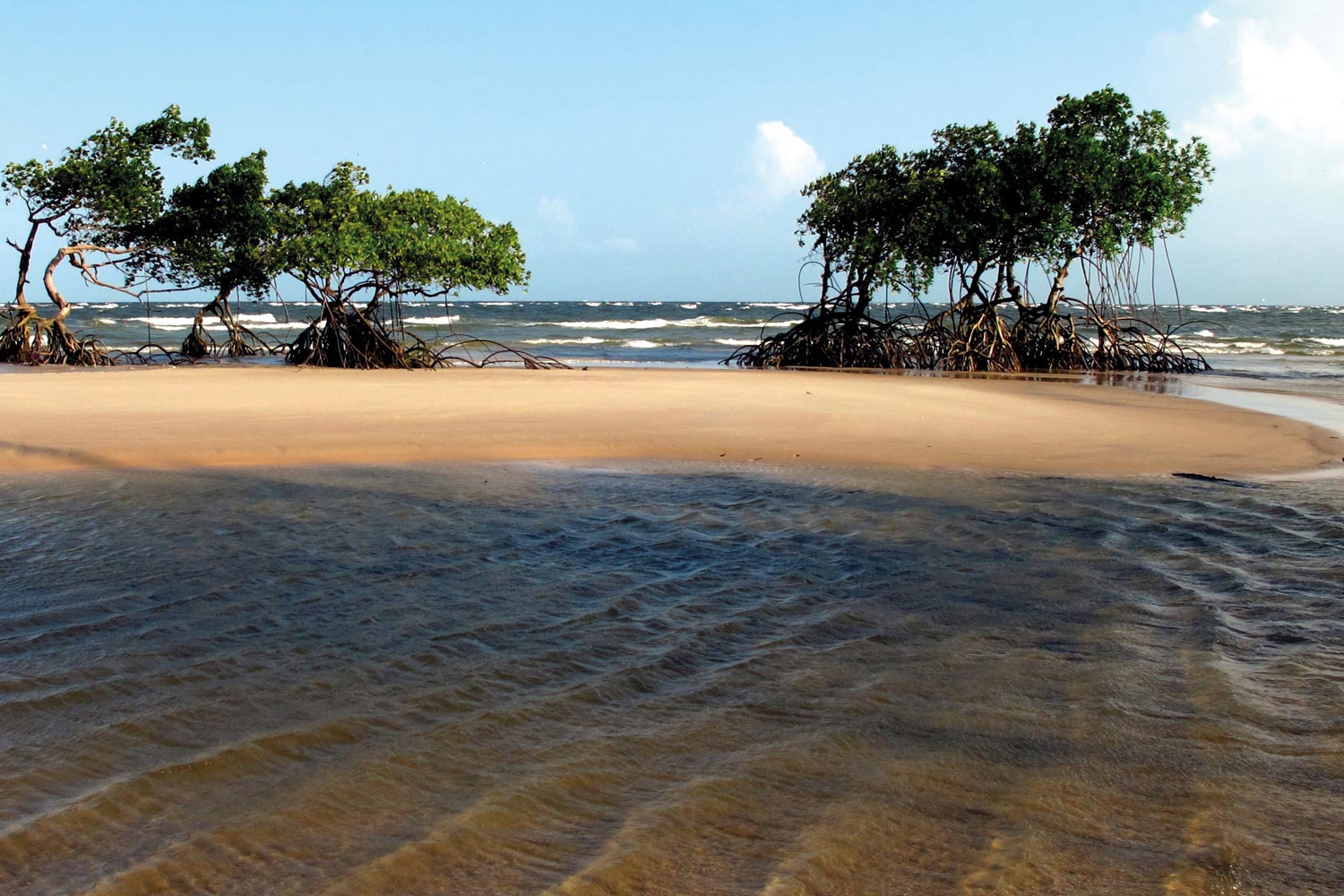
Wikimedia Commons
Beaches on the island of Marajó are losing sand and trees as the sea level risesWikimedia CommonsThe issue of progradation has been observed on 35% of the coast of Espírito Santo. In the Parnaíba river delta, between the states of Maranhão and Piauí, erosion has unearthed mangroves previously covered by sand. In Rio Grande do Norte, 60% of the 399 km shoreline has been affected by erosion. Ceará has 572 km of coastline, 30% of which has suffered erosion and 10% progradation.
In the Southeast and South of the country, erosion and progradation affects roughly 15% of the coast, but this is still a cause for concern, warns geographer Dieter Muehe, a researcher at the Federal University of Espírito Santo (UFES) and coordinator of the two surveys. Field analyses and satellite images indicated that 38% of the coast of Rio de Janeiro and 12% of São Paulo, equivalent to 242 km and 75 km respectively, show signs of erosion, but with no change to the shoreline. “The widths of the beaches remain the same, but erosion is having an impact on the dunes, cliffs, and nearby houses in some regions,” he says. “These areas are highly vulnerable, and this phenomenon will likely become more apparent in the next few years.”
A natural problem
Originally a naturally occurring phenomenon, erosion is a worldwide problem. The most affected region is the Caspian Sea, where the beaches have lost an average of 600 m in some areas and gained as much as 700 m in others. The coasts of countries in Asia, South America, East Africa, and Western Australia were eroded by more than 50 m on average, according to a study published in Scientific Reports in August 2008. As in other countries, alterations to the sediment volume in Brazil were more significant in urbanized areas with ports, sewage pipes leading into the sea, or houses and hotels built along the beach. “Construction works interrupt the sediment flow, meaning beaches accumulate sand on one side and lose it on the other,” says Muehe.
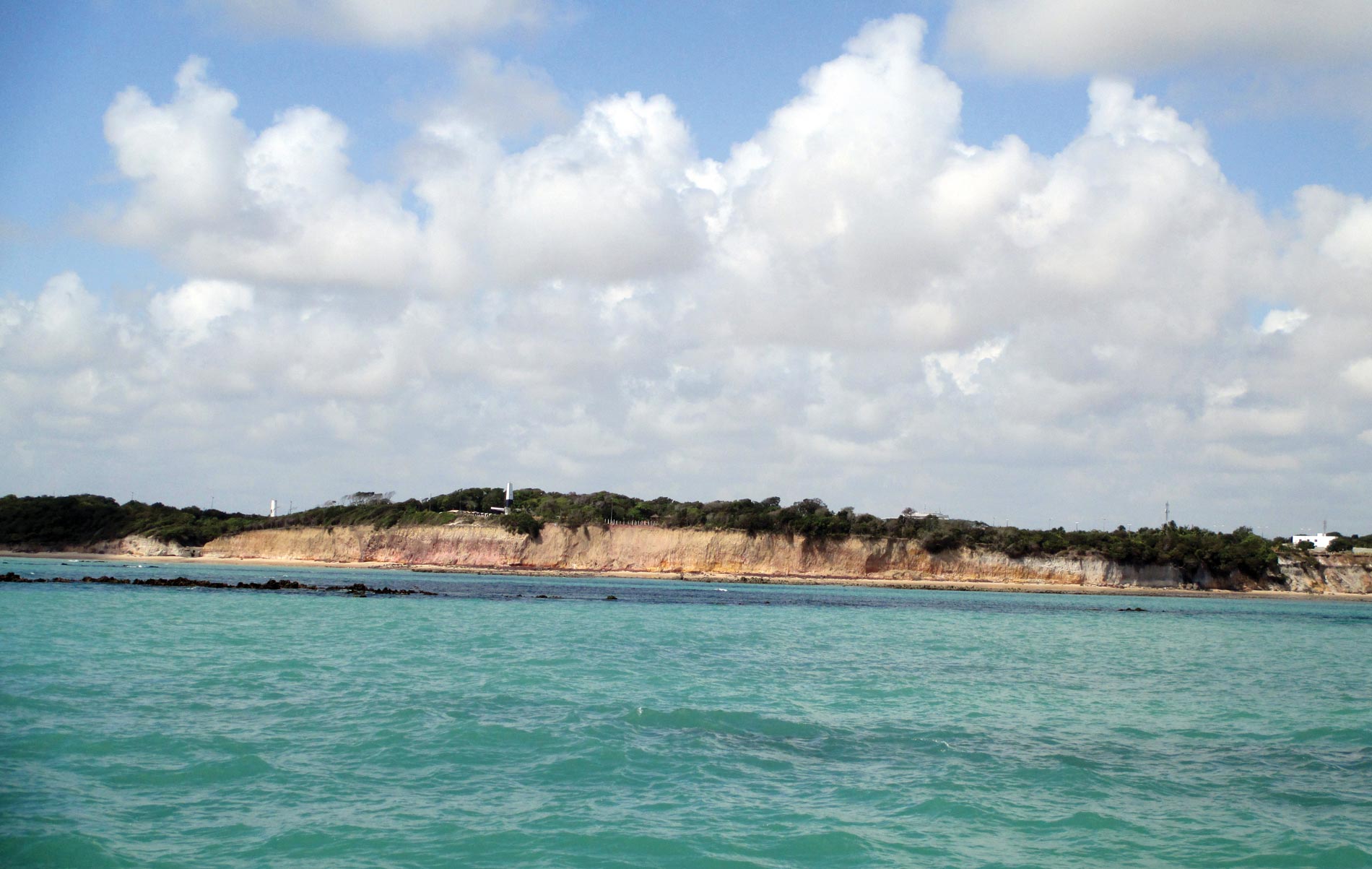
Carlos Fioravanti
The cliff below the Ponta do Seixas lighthouse in João Pessoa suffers continuous erosionCarlos FioravantiIn the chapter on Ceará, geologist Jader Onofre de Morais, a professor at the State University of Ceará (UFC), reported that 100 coastal protection projects had been implemented in the state prior to January 2016, the majority (75%) in the metropolitan region of the state capital, Fortaleza. Sea walls and stone corridors, however, were not enough to retain the sediment. In the municipalities of Cascavel and Fortim, the shoreline retreated by 150 and 300 m respectively due to rising sea levels, which destroyed houses, roads, and moorings. Boa Viagem beach in Recife continues to suffer serious erosion, mostly due to the breakwater built to stop strong waves from hitting the beaches.
The North and Northeast regions of Brazil are the most affected, partly because of the stronger tides and the low incline of the beaches, which suffer more from rising sea levels, among other factors. Prolonged droughts in the Northeast in recent years have exacerbated the situation. With less water, the rivers carry less sand to the coast, while the sea continues to remove the sediment already deposited on the beaches.
“Simply reducing the flow of a river is enough to increase the effects of erosion,” says geologist José Maria Landim Dominguez, a professor at the Federal University of Bahia (UFBA), who coordinated two chapters of the book, one on Paraíba and the other on Alagoas, Sergipe, and Bahia. The volume of sediment being deposited on beaches is also impacted by dams and the removal of sand from river banks for use in construction and paving. In 1998, erosion destroyed the village of Cabeço, located at the São Francisco river mouth on the border between the states of Alagoas and Sergipe.
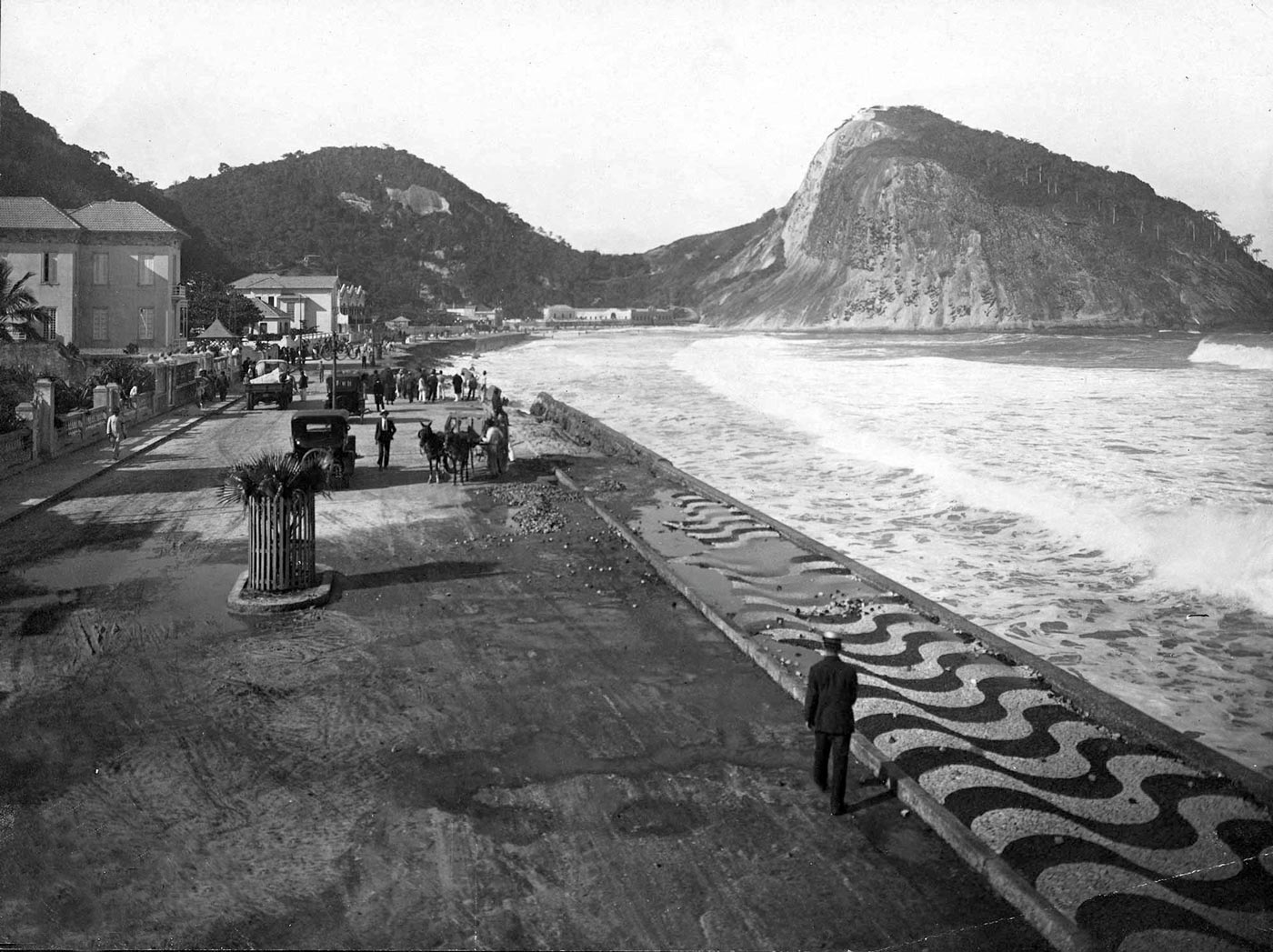
Wikimedia Commons
In 1921, Copacabana beach was narrower and the sea often reached the roadWikimedia CommonsSediment movement could be aggravated by rising sea levels and increasingly frequent heavy rainfall and cyclones expected over the coming decades as a result of climate change, warn experts who participated in the study. “The level of construction along the coast is a significant factor in the erosion of the São Paulo shoreline, but it is much easier to blame global warming than businesses and the government,” says geologist Michel Mahiques, a professor at the Oceanographic Institute of the University of São Paulo (IO-USP) and coordinator of the chapter on the state of São Paulo. “The responsibility and costs of mitigating these problems must be shared among the contributing causes.”
Methods and Measures
There are many uncertainties that make it difficult to plan for and combat the destruction of beaches. Every research group adopts a different methodology, some more accurate than others, to measure changes to the coastline, the results of which are essential to calculating possible sediments losses or gains. To overcome this problem, oceanographer Régis Pinto de Lima, general coordinator of coastal management at the MMA, plans to bring together experts to properly define how the boundary between the sea and land is determined. This parameter was first established in Brazil in 1831 and needs to be updated, says Lima.
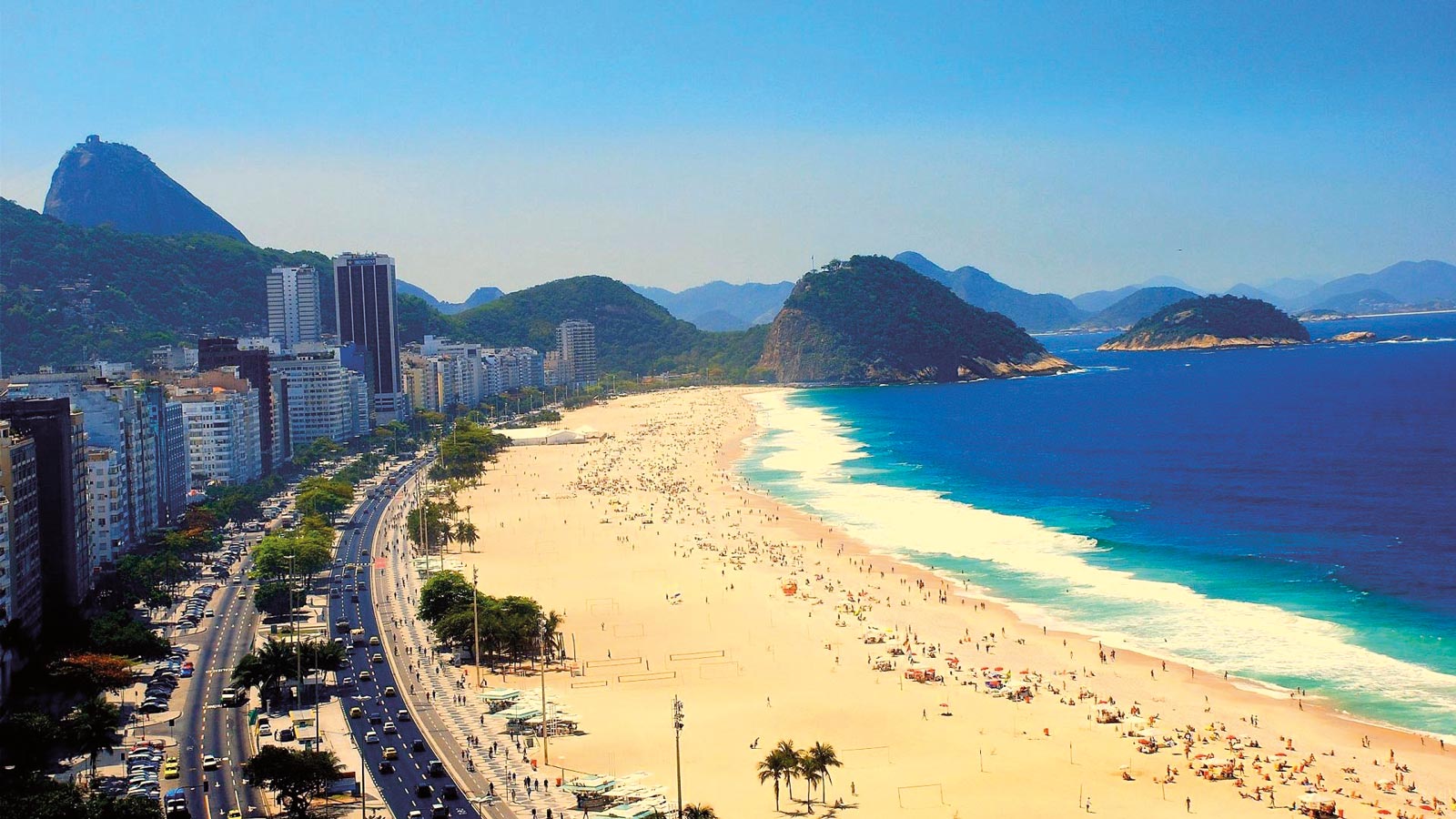
Wikimedia Commons
The problem was solved by expanding the beach with sand from nearby areasWikimedia CommonsHis team is due to release a manual this month, targeted primarily at representatives of public agencies, with guidelines on constructing buildings along the coast and reducing the movement of sediment. Mahiques believes that “local authorities must be involved, including in the hiring of oceanographers, geographers, geologists, and other professionals trained to analyze these problems.” Dominguez, from UFBA, adds: “Public agencies should have stricter rules to prevent construction in vulnerable areas, such as at river mouths.” Today, building is prohibited within 50 meters of the shoreline.
What exists, for the time being, are isolated damage reduction works. In April, Santos city hall completed a project designed to stop erosion in Ponta da Praia by installing a 500-meter submerged barrier made of 49 sandbags; the beach lost almost 80,000 cubic meters of sand between 2013 and 2016. In May, the newspaper Gazeta, based in Vitória, Espírito Santo, reported that 10 truckloads of sand were being removed from Camburi beach per day to replace what has been lost at Curva da Jurema, another beach in the city. In 2017 and 2018, the Brazilian Ministry of National Integration approved 11 funding applications for emergency works to combat coastal erosion requested by state or municipal agencies in Bahia, Ceará, Rio Grande do Norte, Pará, and Santa Catarina, totaling approximately R$500 million. Restoration of the Ponta Negra beach in Natal, Rio Grande do Norte, received R$17.6 million in funding.
The MMA also encourages so-called light works, where beaches are recomposed with sand instead of rigid structures that retain sediment without preventing erosion. A successful example of this approach is Copacabana beach in Rio de Janeiro, which was enlarged with sand from neighboring areas in the 1970s. The beach and the road alongside it used to be narrower, and the sea at times would crash against the doors of the Copacabana Palace hotel; today it never gets closer than 10 m from the sidewalk.
“Recomposing a beach with sand more closely mimics the natural replacement processes that occurred in the past,” says oceanographer Antonio Henrique Klein, a professor at the Federal University of Santa Catarina (UFSC). “Managers approve the projects, but sometimes forget that they need maintenance from time to time,” he notes. “Lost sand has to be continually replaced to prevent the problems from recurring—a location suffering natural erosion will continue to erode.”
Book
MUEHE, D. (org.) Panorama da erosão costeira no Brasil. Brasília, DF. Environment Ministry, 2018
Scientific article
MENTASCHI, L. et al. Global long-term observations of coastal erosion and accretion. Scientific Reports. Vol. 8, no. 12876, pp. 1–11. Aug. 27, 2018.


